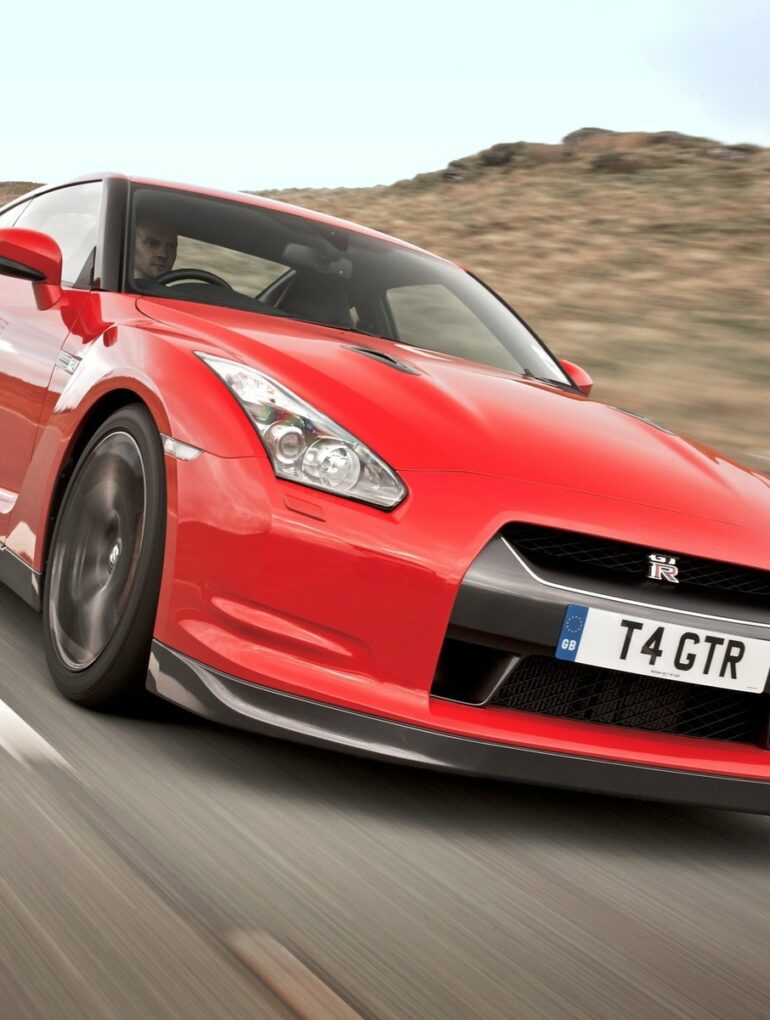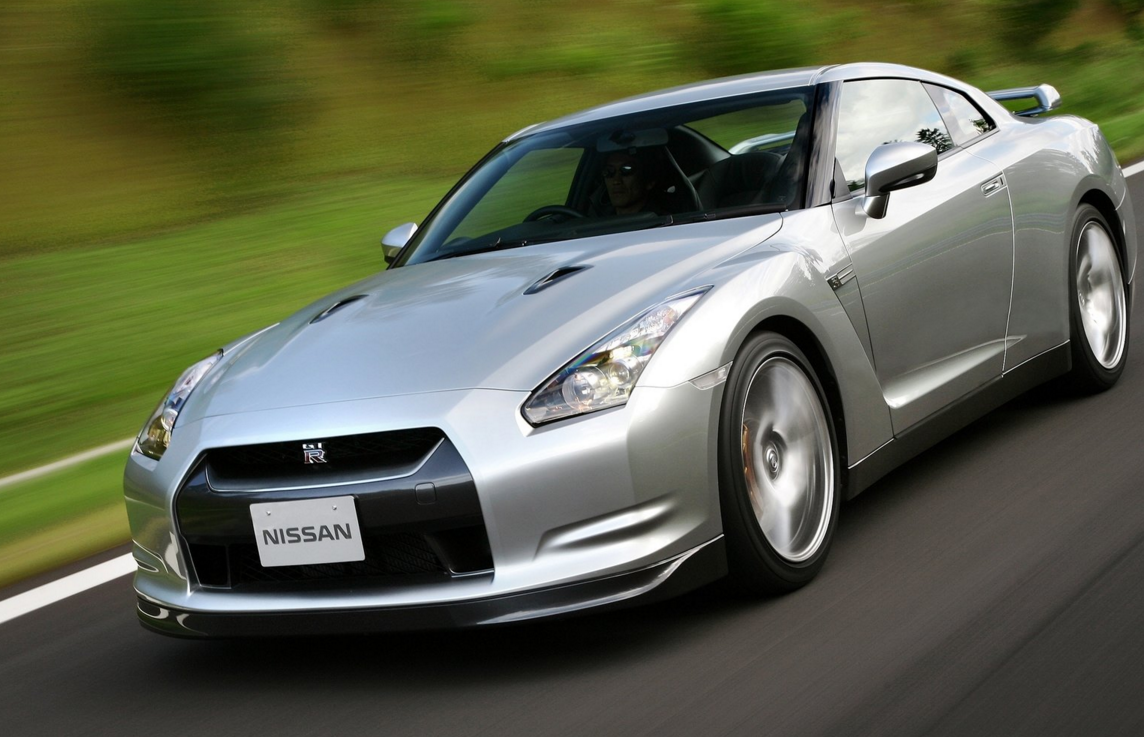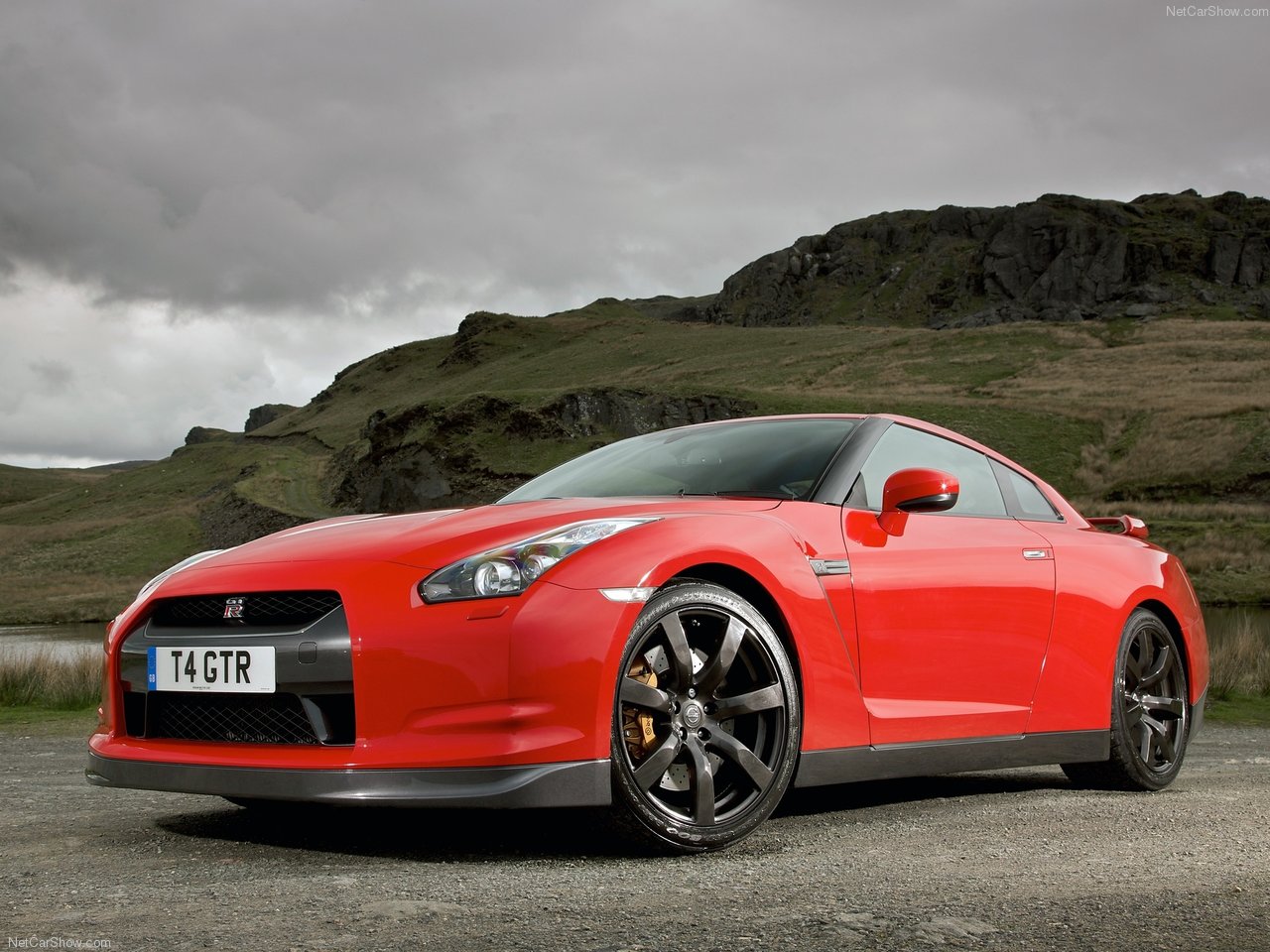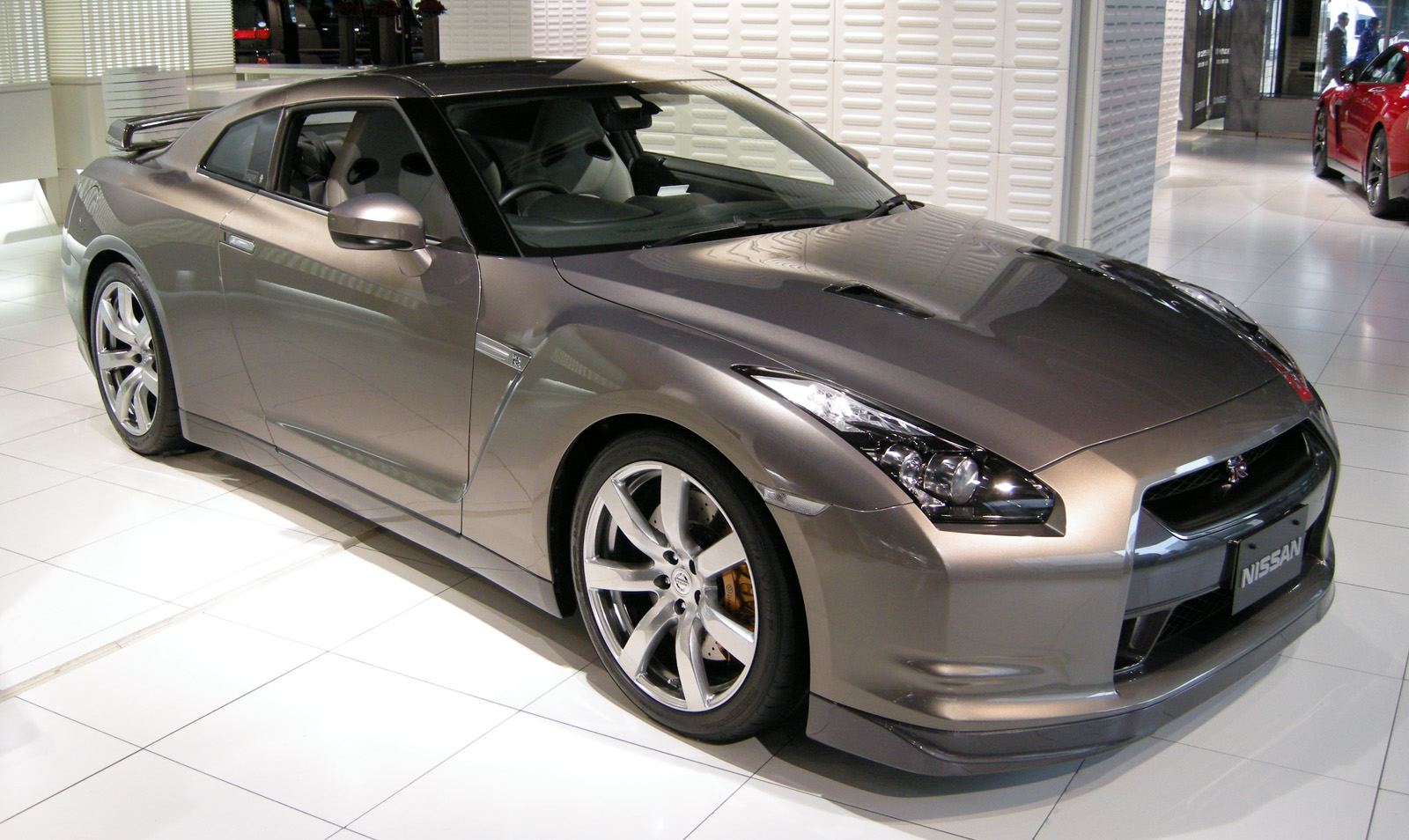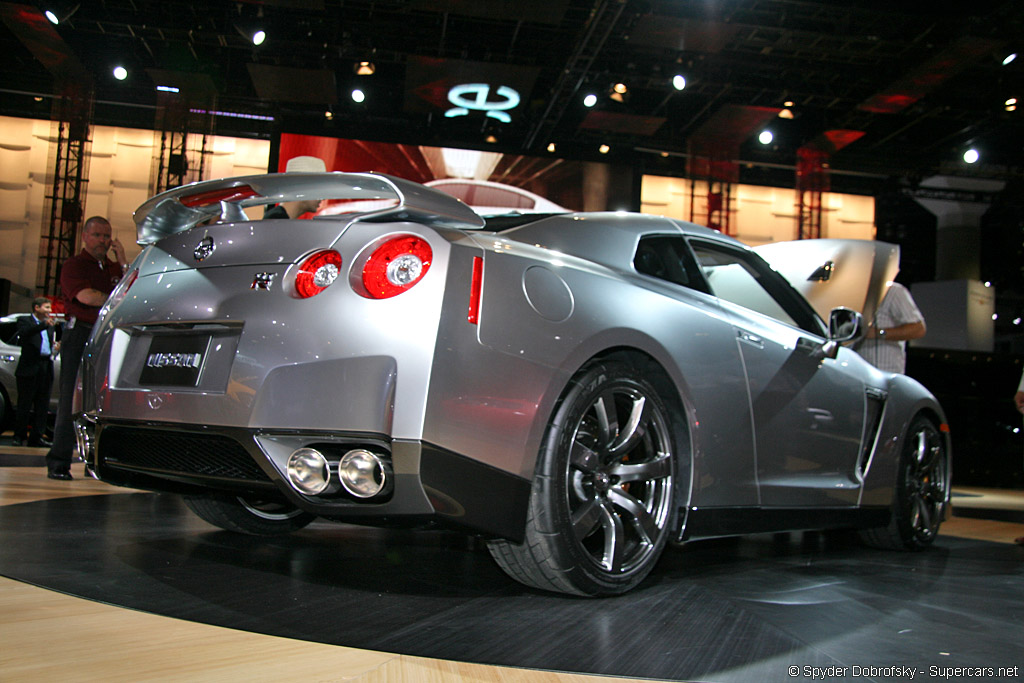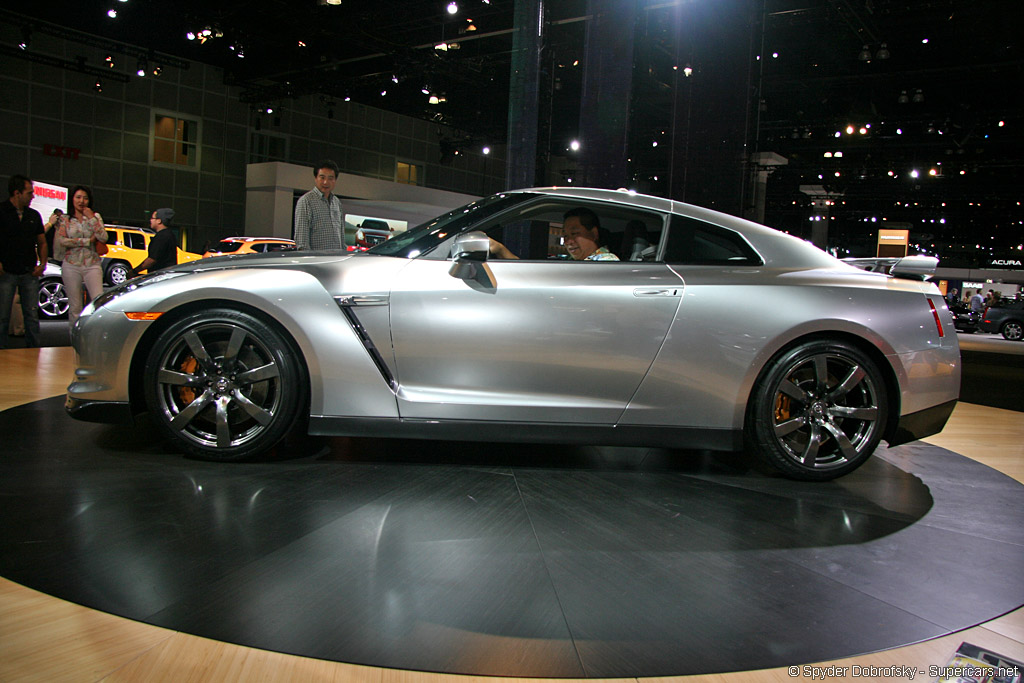2008 Nissan GT-R
Often touted as a supercar for the playstation generation, the Nissan GT-R offers wholesale performance from a lineage that includes the legendary R34 Skyline. With early versions, acceleration was as fast as 60 mph in 3.2 seconds, but a revision in 2010 reduced this to 3.7 for reliability of the $20,000 USD transmission. For a while, it was also the fastest production car to lap the Nürburgring circuit with a time of 7:26.7 on standard Dunlop tires, alhtough this was disputed by Porsche.
Designer Shirō Nakamura credits giant robots of the Gundam series as inspiration for the design. It also takes cues from the much smaller R34 Skyline GT-R. He described the car as “unique because it is not simply a copy of a European-designed supercar, it had to really reflect Japanese culture.”
The GT-R received praise from almost corner of the media. EVO Magazine even named it “car of the decade.”
Press Release
TOKYO (Oct. 24, 2007) – Nissan Motor Co., Ltd., today announced the launch of the Nissan GT-R, a new multi-dimensional performance machine that lives up to the concept of “an ultimate supercar for anyone, anywhere, at anytime”. The Nissan GT-R features a newly developed Premium Midship package, including the world’s first independent transaxle 4WD developed independently by Nissan. The Nissan GT-R will be available in Japan mainly through Nissan High Performance Centers nationwide from December 6th.
The Nissan GT-R was developed with a new understanding and appreciation of the Earth’s natural forces gravity, inertial force and aerodynamics and translates those forces into a completely new design, maximizing tire grip and airflow.
Basic vehicle dynamics and integration with the driver have also been examined, resulting in new componentry and creating a Human-Machine Interface (HMI) never seen before in the marketplace. All of these theories have been integrated to balance “speed and efficiency,” “high-output with environmental consideration” and “high performance and safety.”
2008 Nissan GT-R Gallery
See Full 2008 Nissan GT-R Gallery
2008 Nissan GT-R Videos
See More Nissan GT-R Videos
Taking these factors into account, Nissan created the all-new Nissan GT-R, which offers advanced high performance for secure and enjoyable driving by minimizing the effects of climatic, road condition or driving technique limitations. The Nissan GT-R offers ultimate performance for virtually every driving situation whether it be the Nurburgring circuit, to snow, rain or urban areas all manageable by the GT-R driver through advanced technology and driving dynamics.
The Nissan GT-R’s unique characteristics are instilled not just in the vehicle’s design, but also through a specialized production process. Carbon fiber, aluminum and steel components are assembled with a special high-precision process, which includes a series of vibration tests. Engines and transmissions are assembled by a single craftsman in a “clean room” environment and upon completion, every GT-R undergoes a battery of comprehensive tests to ensure the proper operation of all vehicle components.
To properly support the all-new GT-R, Nissan has established special Nissan High Performance Centers, where all certified advisors and technicians have received extensive training. Total support for the GT-R owner is offered for the first three years of ownership, including measurement and adjustment of the engine, transmission and wheel alignment after the first 1000 km, and again every 12 months, free of charge.
Packaging and Driveline Suited for a Supercar
The all-new Nissan GT-R uses a Premium Midship package, an all-new, more advanced version Front Midship (FM) package utilized on other Nissan vehicles. This new package enables the use of the world’s first application of an independent transaxle 4WD system. The transaxle’s layout places the dual-clutch transmission, transfer case and final drive at the rear of the vehicle (instead of the usual front location), which enables vehicle weight to be evenly distributed throughout the car. This gives the Nissan GT-R a superb front-to-rear weight balance, while enhancing leg and foot space and allowing for an optimal pedal layout.
Under the hood, the Nissan GT-R features an all-new 3.8-litre twin turbo V6 VR38 engine, featuring plasma-sprayed bores and a special twin-turbo exhaust manifold system. A secondary air management system enables the newly designed powerplant to provide approximately 40kg/m of torque during ordinary low-rev driving, which gives an optimum air-fuel ratio for around-town efficiency and helps the Nissan GT-R meet ultra-low emission vehicle (U-LEV) standards in Japan.
The Nissan GT-R’s new engine produces 480PS (353kW) at 6400rpm and maximum torque of 60kgm (588Nm) from 3200 to 5200rpm. Putting the power to the ground is an all-new GR6-type dual clutch transmission, with paddle shifting and a Borg Warner six-plate dual clutch for direct control.
Suspension duties are handled through a special Bilstein DampTronic*1 system, which utilizes all pertinent vehicle information to provide appropriate damping forces for all situations and helps maintain a high level of control for straight-line driving, cornering, and braking.
Braking is essential for a daily-driven supercar and the GT-R features large Brembo full-floating drilled rotors, low steel high stiffness brake pads and Brembo mono block six-piston front and four-piston rear calipers, which in combination minimize fade and provide stable braking. Run-flat tires, exclusively designed for use on the Nissan GT-R, balance high grip and all-weather capabilities and a comfortable ride in all driving situations. The tires are designed to maintain structure for 80km of travel at 80 km/h, while still providing an acceptable level of performance.
High-Performance Safety and Environmental Technologies
The Nissan GT-R offers a long list of safety and environmental features, including, for enhanced visibility inside and out of the vehicle, high-mounted LED stoplamps, bright LED rear combination taillights, super wide beam headlights, heated door mirrors and flat-blade wipers.
Standard safety equipment includes a pop-up engine hood system for enhanced pedestrian safety, driver and front passenger SRS Air Bag System, ELR front seat belts with tension reducer, front seat belts with load limiter, and three-point ELR rear seat belts. Driver and front passenger SRS Side Air Bag System and SRS Curtain Air Bag System are offered as options.
Environmental technologies include extensive work to create an U-LEV certification in Japan for the 3.8-liter twin turbo engine and reduced levels of volatile organic compound for materials used in the car.
Functional Design High Performance Aerodynamics and Style
The Nissan GT-R’s styling follows the function over form theory. Every styling aspect, from the overall design to the smallest details, is created to maximize the vehicle’s driving experience as well as suggesting GT-R’s supercar level of performance. Utilizing advanced aerodynamics, the Nissan GT-R’s aggressive styling evokes the lines of a well-trained athlete, combining strong character lines with smooth and solid areas.
The all-new GT-R’s body is created with a combination of steel, carbon fiber and aluminum, providing a unique combination of stiffness and lightness. The Nissan GT-R features a low coefficient of drag of 0.27, with high front and rear downforce, which provides the GT-R with enhanced grip in all weather situations, while also enhancing fuel efficiency.
The front fenders express power and stability, while the “aero-blades” on the fenders’ leading edges provide optimum airflow around the tires and along the body. The scoop in the fenders’ trailing edges assists in providing front downforce and optimization of side airflow. The aggressive front end, with a large hood budge and single air intake, provides a sophisticated style as well as undisturbed airflow for power and cooling. New “super wide beam” headlights feature three additional sub-reflectors (compared to conventional lights) to give a wider spread to the illumination area.
The Nissan GT-R’s large, four-passenger cabin features a sloping aero blade canopy roofline and curved C-pillar sword edge, which expresses the distinctive GT-R identity, as well as facilitating air flow around the rear of the vehicle. The GT-R’s hallmark four-ring taillights, efficient rear spoiler and large, integrated φ120 exhaust tips, provides the signature rear view of the GT-R, as well as optimizing airflow along the top and under the vehicle.
The high level of advanced technology is evident even in the Nissan GT-R’s paint which utilizes a “double clear coat” and “anti-chipping” process. The Nissan GT-R features Ultimate Silver as a special new color, which is painstakingly hand-polished by craftsman.
An Interior Suitable for Daily Driving or Supercar Duties
Key to the Nissan GT-R’s usability as a both daily driver and a high-performance supercar is its interior, which is designed to balance functionality, a sense of ease, and comfort.
Sculpted performance bucket seats give the driver and passenger a comfortable driving experience, and soft pads are utilized on the dash in front of the passenger and doors to give an extra level of comfort and safety.
The instrument panel surrounds the driver, with all meters and multi-function meter at a uniform height to minimize the driver’s head movement when traveling at high speeds. A large center-mounted tachometer, with gear display on its upper right, as well as the easy-to-read graphics of the display, gives the driver instant detailed information, essential for the performance nature of the GT-R.
Functional style is also evident in the Nissan GT-R each meter features a dial plate design that evokes the idea of engaged gears, as well as a three-dimensional metal-like ring, suggesting the multi-dimensional performance of the GT-R. A large, metallic-framed center console features the ergonomically designed shift lever and a red “engine start” button.
Adjustability is central to the daily-driver nature of the Nissan GT-R, with a special “set-up switch” located in the center of the instrument panel. This switch enables the driver to adjust transmission shifts, shock absorbers and the Vehicle Dynamic Control (VDC-R) in three settings Normal, Comfort or R, the high-performance setting designed for the Nissan GT-R supercar application.
A high-speed, high-capacity CARWINGS (Japan market) navigation system, with a powerful 30GB hard disk drive, features an easy-to-use touch pad, as well as traditional navigation switches. The screen interface features not only the navigation system, but also an enriched entertainment system with a Music Box hard drive, DVD and CD player, and Bluetooth audio function.
For special use in the GT-R application, the multi-function meter also includes mechanical and driving information for safe high performance driving, including acceleration opening, brake pedal pressure, and steering angle. It also includes an “optimal gearshift map,” to emphasize economical vehicle operation.
A specially designed BOSE sound system includes two forward-facing woofers in the rear center armrest area combined with traditional door speakers. All speakers are mounted in rigid aluminum die cast panels, which combined with the design of the system itself, provide sound quality suitable for a supercar.
Pricing and Sales Target
200 units / month
Drivetrain Engine Grade Transmission Price (yen, Consumption tax included)
GT-R GR6-type dual 7,770,000
4WD VR38DETT GT-R Black edition clutch 7,927,500
GT-R Premium edition transmittion 8,347,500
In Detail
| type | Series Production Car |
| released at | 2007 Tokyo Auto Show |
| built at | Tochigi, Tochigi, Japan |
| body stylist | Shirō Nakamura |
| engineers | Kazutoshi Mizuno |
| price $ | $ 69,850 |
| price £/td> | £56,795 |
| price ¥/td> | ¥7,700,000 |
| engine | VR38DETT6 Alloy 60 Degree V6 |
| position | Front, Longitudinal |
| aspiration | IHI Twin Turbochargers in Manifold System |
| block material | Aluminum |
| valvetrain | DOHC, 4 Valves per Cyl |
| fuel feed | Electronic Multipoint Fuel Injection |
| displacement | 3799 cc / 231.8 in³ |
| bore | 95.5 mm / 3.76 in |
| stroke | 88.4 mm / 3.48 in |
| compression | 9.0:1 |
| power | 352.7 kw / 473 bhp @ 6400 rpm |
| specific output | 124.51 bhp per litre |
| bhp/weight | 270.29 bhp per tonne |
| torque | 588.42 nm / 434 ft lbs @ 3200 rpm |
| redline | 7000 |
| body / frame | CBA-R35 Unit Steel |
| driven wheels | ATTESA ET-S All-Wheel Drive (AWD) w/Carbon-Composite Driveshaft to Rear Transaxle, Transfer Case |
| wheel type | Rays Forged Wheels in Gunmetal Gray Finish |
| front tires | P255/40R-20 Dunlop SP Sport |
| rear tires | P255/40R-20 Dunlop SP Sport |
| front brakes | Vented Brembro Discs w/6-Piston Calipers, ABS, EBD, BA |
| rear brakes | Vented Brembro Discs w/4-Piston Calipers, ABS, EBD, BA |
| front wheels | F 50.8 x 24.13 cm / 20 x 10.5 in |
| rear wheels | R 50.8 x 26.7 cm / 20 x 10.5 in |
| steering | Rack & Pinion w/Speed Sensitive Variable Assist |
| f suspension | A-Arms w/Bilstein Damptronic Shock Absorbers, Coil Springs, Anti-Roll Bar |
| r suspension | A-Arms w/Bilstein Damptronic Shock Absorbers, Coil Springs, Anti-Roll Bar |
| curb weight | 1750 kg / 3859 lbs |
| wheelbase | 2779 mm / 109.4 in |
| front track | 1590 mm / 62.6 in |
| rear track | 1600 mm / 63 in |
| length | 4655 mm / 183.3 in |
| width | 1895 mm / 74.6 in |
| height | 1370 mm / 53.9 in |
| transmission | 6-Speed Dual Clutch Automatic Transmission |
| gear ratios | 4.06:1, 2.30:1, 1.60:1, 1.25:1, 1.00:1, 0.80:1 |
| final drive | 3.70:1 |
| top speed | ~310.54 kph / 193 mph |
| 0 – 60 mph | ~3.5 seconds |
| 0 – 100 mph | ~8.5 seconds |
| 0 – 1/4 mile | ~11.7 seconds |
| drag | 0.27 Cd |
| fuel econ epa | 14 L/100 km or 17 mpg-us |


